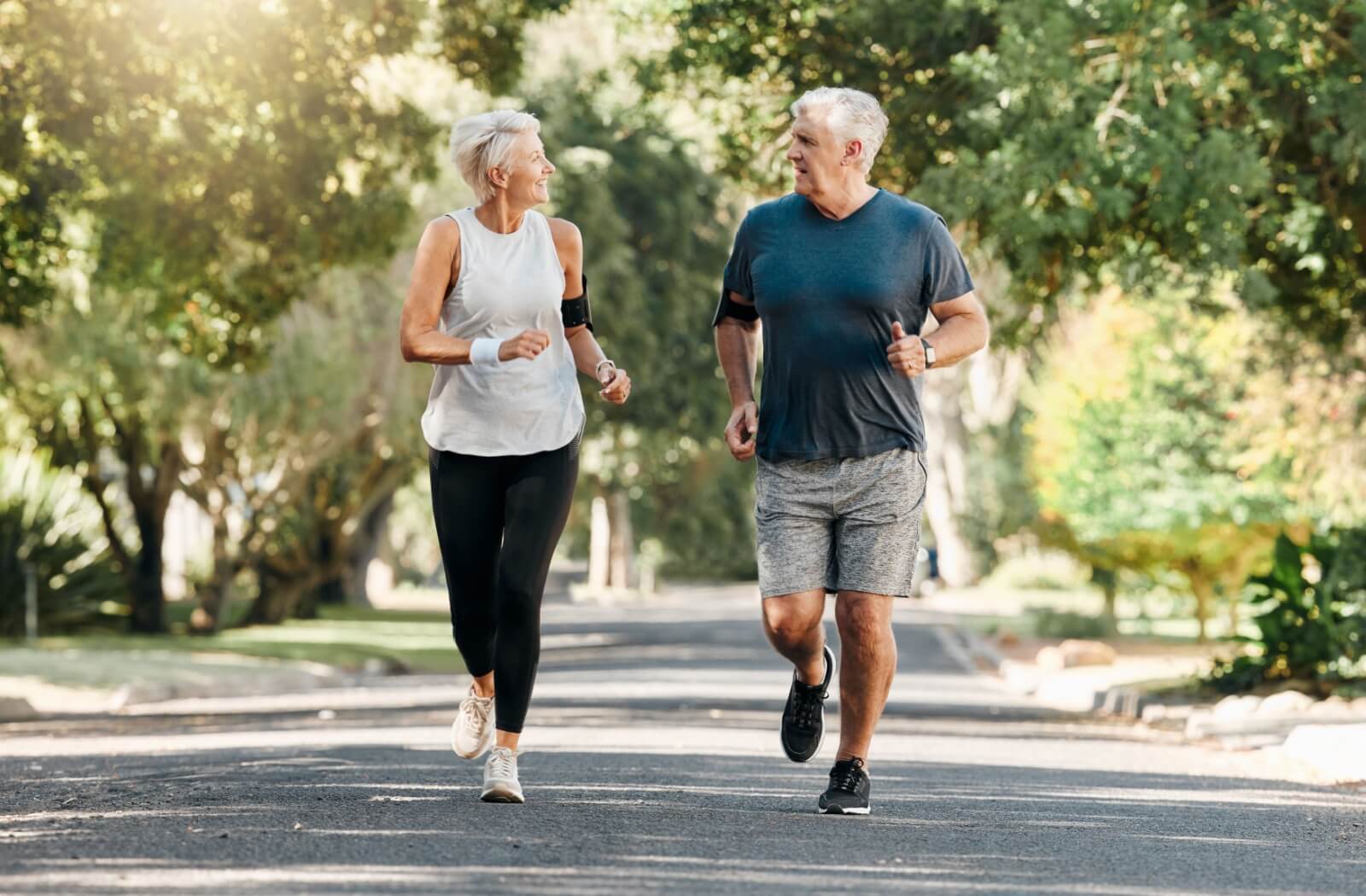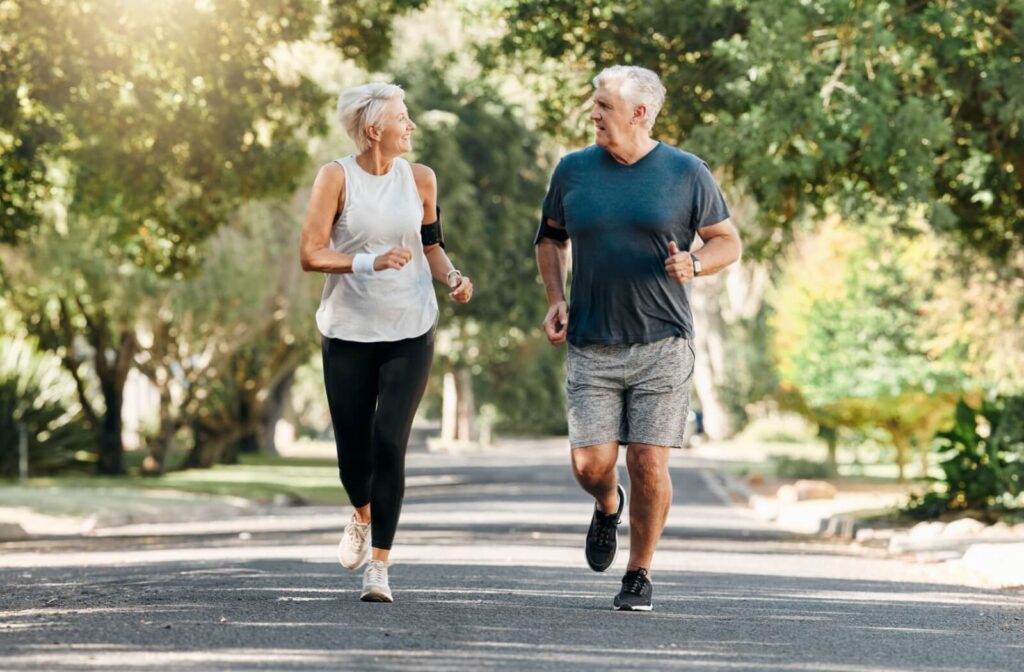Osteoporosis is a common concern among seniors, but the good news is that exercise can play a key role in improving bone health and overall well-being. Seniors can build strength, enhance balance, and protect their bones from fractures with the right activities, such as osteoporosis exercises like weight-bearing, low-impact aerobics, and resistance band workouts.
These safe and effective exercises can be done independently to protect bone health. However, many senior living communities provide structured fitness programs to help you take the guesswork out of these exercises.
What Is Osteoporosis?
Osteoporosis is a bone disease that causes bones to weaken, becoming fragile and more prone to fractures. It predominantly affects seniors, especially women over the age of 50. According to the National Osteoporosis Foundation, approximately 10 million Americans have osteoporosis, and another 44 million have low bone mass, increasing their risk of developing the condition.
For seniors, osteoporosis can significantly impact daily life. Simple activities like bending over, lifting objects, or even minor falls can lead to fractures, commonly in the hips, wrists, or spine. That’s why proactive measures like exercise are essential—not only for preserving bone health but also for maintaining independence.
How Exercise Supports Bone Health
While medication can help manage osteoporosis, exercise is one of the most effective ways to strengthen bones. Regular physical activity stimulates bone-forming cells, improving bone density and flexibility. Additionally, exercise strengthens muscles, which helps protect bones from injuries by improving balance and coordination.
The key is to focus on safe, low-impact exercises to enhance bone health. Below, we explore seven osteoporosis-focused exercises seniors can incorporate into their fitness routine.
7 Great Osteoporosis Exercises for Seniors
1. Weight-Bearing Exercises
Weight-bearing exercises force your bones to support your weight, which encourages the production of bone tissue. Examples include brisk walking, light jogging, or simple activities like gardening or dancing.
- Why It Works: Regular weight-bearing activities help improve the density of bones in your legs, hips, and spine.
- Pro Tip: Start with short, 10-minute walks daily and gradually increase your time as you feel comfortable.
2. Low-Impact Aerobics
Low-impact aerobics keep bones and joints active without putting too much stress on them. Options like water aerobics, elliptical machines, or low-impact cardio classes are great for seniors.
- Why It Works: This activity strengthens bones while reducing the risk of injury.
- Pro Tip: Check out local fitness centers or senior living communities for low-impact aerobics classes tailored to your needs.
3. Strength Training with Light Weights
Using light weights or even resistance machines can promote muscle and bone strength. Focus on exercises like bicep curls, squats, and leg lifts.
- Why It Works: Strength training enhances muscle mass, improves balance, and reduces the risk of falls.
- Pro Tip: For optimal results, start with light weights (1-3 pounds) and aim for two weekly sessions.
4. Yoga & Pilates for Flexibility & Balance
Both yoga and Pilates are excellent for improving flexibility, posture, and balance. Many poses and stretches help strengthen the spine and the lower body.
- Why It Works: These practices improve coordination and reduce the likelihood of falls, which is critical for seniors with osteoporosis.
- Pro Tip: Opt for classes designed for seniors or osteoporosis-friendly routines to minimize the risk of overstressing your bones.
5. Tai Chi for Balance & Coordination
Tai chi is a gentle form of martial arts that combines slow, flowing movements with deep breathing techniques. It’s excellent for both the body and mind.
- Why It Works: Tai chi enhances balance and stability, particularly in the hips and knees, helping to prevent falls.
- Pro Tip: Look for beginner classes led by qualified instructors who understand osteoporosis safety.
6. Posture Exercises for Spine Health
Posture exercises strengthen the muscles around the spine and help prevent slouching, which can lead to compression fractures in people with osteoporosis. Simple stretches and alignment drills can improve overall spinal health.
- Why It Works: A strong, upright posture supports the spine and reduces the risk of fractures.
- Pro Tip: Incorporate stretch bands or stability balls for added support.
7. Resistance Band Exercises
Resistance bands add controlled tension to movements, helping to strengthen muscles safely. Exercises like seated rows or lateral arm raises are practical for seniors.
- Why It Works: Resistance band exercises strengthen bones and muscles while being gentle on joints.
- Pro Tip: Opt for bands with light resistance and perform slow, smooth movements to avoid strain.
How Osteoporosis Exercises Build Strength

Osteoporosis-specific exercises target the bones, muscles, and coordination required to protect them. Stronger muscles cushion your bones, reducing the likelihood of fractures during minor falls or accidents.
For example, squats strengthen the legs, ensuring better stability and mobility, while posture exercises help align the spine, reducing stress and strain. Regular exercise also increases your confidence in physical movements, encouraging a more active lifestyle.
Exercise Tips to Protect Your Bones
Safety should always come first when starting an osteoporosis exercise routine. Here are some essential tips for staying safe while staying active:
- Consult Your Doctor: Always check with your healthcare provider before beginning a new exercise program to ensure it’s safe for your condition.
- Warm-Up and Cool-Down: Prepare your body for activity with gentle stretches and cool down afterward to help avoid injuries.
- Avoid High-Impact Movements: Steer clear of exercises like running or jumping, which can stress fragile bones.
- Listen to Your Body: Stop immediately and consult your doctor if you experience pain or discomfort during an exercise.
- Use Proper Equipment: From good-quality shoes to resistance bands, ensure your exercise gear supports your safety.
How Senior Living Supports Fitness for Seniors
Many senior living communities go the extra mile to promote health and fitness for older adults. These communities often provide the following benefits:
- Onsite Fitness Classes: Including yoga, Pilates, and strength training tailored to seniors.
- Access to Wellness Experts: Trainers and instructors with knowledge of osteoporosis exercises.
- A Supportive Environment: Group activities foster residents’ sense of belonging and camaraderie.
- Convenience and Safety: Exercise facilities have senior-friendly features to minimize risks.
Joining a supportive community ensures you or your loved ones can access the right tools and encouragement to stay active and healthy.
Begin Building Strong Bones Today
Exercise is one of the most effective ways to manage osteoporosis and protect bones. From weight-bearing walks to gentle yoga and resistance training, the right activities can help strengthen your body and independence.
Sarnac Village at Will Rogers provides proper guidance and support for seniors looking to stay active, have an enjoyable and fulfilling life, and improve their health. Contact us today to see how our healthy living services can benefit your loved one.




